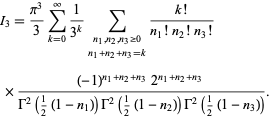
Watson,s Triple Integrals
 المؤلف:
Bailey, D. H.; Borwein, J. M.; Kapoor, V.; and Weisstein, E. W
المؤلف:
Bailey, D. H.; Borwein, J. M.; Kapoor, V.; and Weisstein, E. W
 المصدر:
"Ten Problems in Experimental Mathematics." Amer. Math. Monthly 113
المصدر:
"Ten Problems in Experimental Mathematics." Amer. Math. Monthly 113
 الجزء والصفحة:
...
الجزء والصفحة:
...
 17-9-2018
17-9-2018
 2277
2277
Watson's Triple Integrals
Watson (1939) considered the following three triple integrals,
(OEIS A091670, A091671, and A091672), where  is a complete elliptic integral of the first kind,
is a complete elliptic integral of the first kind,  is a Jacobi theta function, and
is a Jacobi theta function, and  is the gamma function. Analytic computation of these integrals is rather challenging, especially
is the gamma function. Analytic computation of these integrals is rather challenging, especially  and
and  .
.
Watson (1939) treats all three integrals by making the transformations
regarding  ,
,  , and
, and  as Cartesian coordinates, and changing to polar coordinates,
as Cartesian coordinates, and changing to polar coordinates,
after writing  .
.
Performing this transformation on  gives
gives
 can then be directly integrated using computer algebra, although Watson (1939) used the additional transformation
can then be directly integrated using computer algebra, although Watson (1939) used the additional transformation
 |
(25)
|
to separate the integral into
The integral  can also be done by performing one of the integrations
can also be done by performing one of the integrations
 |
(29)
|
with  to obtain
to obtain
 |
(30)
|
Expanding using a binomial series
where  is a Pochhammer symbol and
is a Pochhammer symbol and
 |
(33)
|
Integrating gives
Now, as a result of the amazing identity for the complete elliptic integral of the first kind 
 |
(38)
|
where  is the complementary modulus and
is the complementary modulus and  (Watson 1908, Watson 1939), it follows immediately that with
(Watson 1908, Watson 1939), it follows immediately that with  (i.e.,
(i.e.,  , the first singular value),
, the first singular value),
 |
(39)
|
so
 can be transformed using the same prescription to give
can be transformed using the same prescription to give
where the substitution  has been made in the last step. Computer algebra can return this integral in the form of a Meijer G-function
has been made in the last step. Computer algebra can return this integral in the form of a Meijer G-function
 |
(48)
|
but more clever treatment is needed to obtain it in a nicer form. For example, Watson (1939) notes that
 |
(49)
|
immediately gives
 |
(50)
|
However, quadrature of this integral requires very clever use of a complicated series identity for  to obtain term by term integration that can then be recombined as recognized as
to obtain term by term integration that can then be recombined as recognized as
 |
(51)
|
(Watson 1939).
For  , only a single integration can be done analytically, namely
, only a single integration can be done analytically, namely
 |
(52)
|
It can be reduced to a single infinite sum by defining  and using a binomial series expansion to write
and using a binomial series expansion to write
 |
(53)
|
But this can then be written as a multinomial series and plugged back in to obtain
 |
(54)
|
Exchanging the order of integration and summation allows the integrals to be done, leading to
 |
(55)
|
Rather surprisingly, the sums over  can be done in closed form, yielding
can be done in closed form, yielding
 |
(56)
|
where  is a generalized hypergeometric function. However, this sum cannot be done in closed form.
is a generalized hypergeometric function. However, this sum cannot be done in closed form.
Watson (1939) transformed the integral to
 |
(57)
|
However, to obtain an entirely closed form, it is necessary to do perform some analytic wizardry (see Watson 1939 for details). The fact that a closed form exists at all for this integral is therefore rather amazing.
REFERENCES:
Bailey, D. H.; Borwein, J. M.; Kapoor, V.; and Weisstein, E. W. "Ten Problems in Experimental Mathematics." Amer. Math. Monthly 113, 481-509, 2006b.
Borwein, J. and Bailey, D. Mathematics by Experiment: Plausible Reasoning in the 21st Century. Wellesley, MA: A K Peters, 2003.
Domb, C. "On Multiple Returns in the Random-Walk Problem." Proc. Cambridge Philos. Soc. 50, 586-591, 1954.
Glasser, M. L. and Zucker, I. J. "Extended Watson Integrals for the Cubic Lattices." Proc. Nat. Acad. Sci. U.S.A. 74, 1800-1801, 1977.
Joyce, G. and Zucker, I. J. "On the Evaluation of Generalized Watson Integrals." Proc. Amer. Math. Soc. 133, 71-81, 2005.
McCrea, W. H. and Whipple, F. J. W. "Random Paths in Two and Three Dimensions." Proc. Roy. Soc. Edinburgh 60, 281-298, 1940.
Sloane, N. J. A. Sequences A091670, A091671, and A091672 in "The On-Line Encyclopedia of Integer Sequences."
Watson G. N. "The Expansion of Products of Hypergeometric Functions." Quart. J. Pure Appl. Math. 39, 27-51, 1907.
Watson G. N. "A Series for the Square of the Hypergeometric Function." Quart. J. Pure Appl. Math. 40, 46-57, 1908.
Watson, G. N. "Three Triple Integrals." Quart. J. Math., Oxford Ser. 2 10, 266-276, 1939.
 الاكثر قراءة في التفاضل و التكامل
الاكثر قراءة في التفاضل و التكامل
 اخر الاخبار
اخر الاخبار
اخبار العتبة العباسية المقدسة


